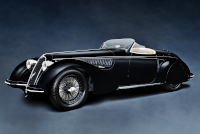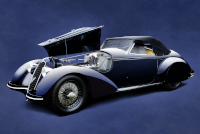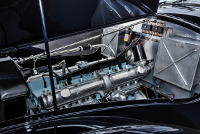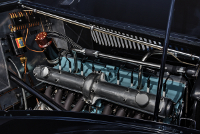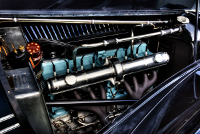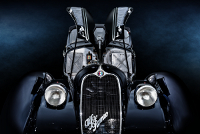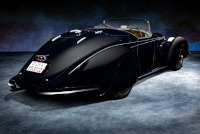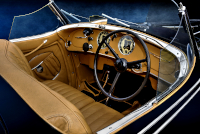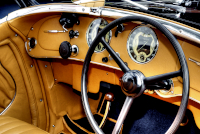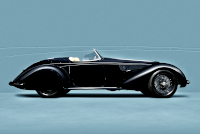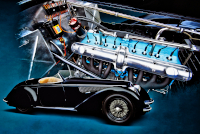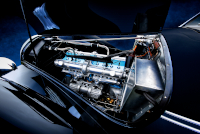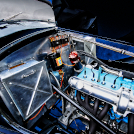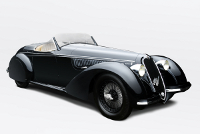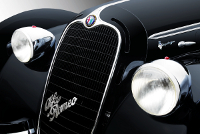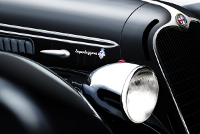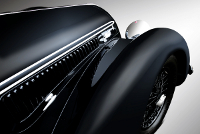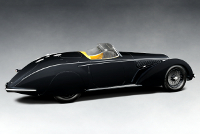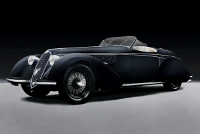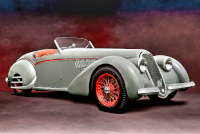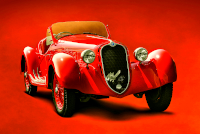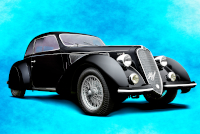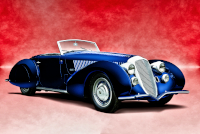Location:
Radnor Hunt Concours d'Elegance, 2015
St. Michaels Concours d'Elegance, 2008
Owner: Oscar Davis (late) | Elizabeth, New Jersey
Prologue:
When we first encountered #412027 in 2008, my excitement over seeing an original 2.9 elicited a sense of privilege just for the opportunity to draft a few images. The car's story lingered in obscurity some while after, at least in my limited view. But by now I've recollected omissions and somewhat rectified missed opportunities to properly illustrate the car's details.
I later corralled a copy of Automobile Quarterly's piece on #412027, published in 1997, followed by the revised edition of Simon Moore's "The Immortal 2.9." Though both pieces are mainly owner histories, I find the car's connection to Egypt in the years leading up to the Suez Crisis its most historically significant chapter. Some great classics wandered far across the earth, skirting violence and political unrest, and this 8C is one such car. I've also been able to answer some long-standing questions, and take an appropriate perspective on what we see in this gallery. Worth the wait, I hope.
Of the images, this set improved with camera technology, where the edit and illustration possibilities available with better sensors, larger resolution, and 16-bit processing eclipse early digital technology in terms of precision. I still enjoy working with older media, particularly images E contributes with the super-wide lens. The images at the end of the set provide a retrospective on old processes, comparison points that demonstrate the gap between first-generation tools and better pro-sumer equipment.
Interestingly, the last shot emerged as one of these accidental Michel Zumbrunn images. The lens actually took on some moisture that day, which softened the image, and I was not sure I could draw a decent car from the template. The posture looked good, though, and I'm still fond of that shot in retrospect, how it worked out.
Overall, it really has been a struggle to compile a 20-piece gallery for an automobile that deserves better than a higgledy-piggledy approach. The real gems are the motor shots. This 8C motor sits atop the list of the most beautiful one might see. In any case, please forgive the hodgepodge approach; it has been about 15 years of puzzling over pictures that should have been better from the start, paired with two major story revisions as I collected more thorough resources. But #412027 is an important piece of the Alfa Romeo portfolio, and hopefully worth the extra time.
- - - - - - - - - -
► Image Source 1-11: Nikon D750 (24.3 MP) at Radnor Hunt in 2015 | Image Source 12-14: Nikon D200 (10.2 MP) by E at Radnor Hunt in 2015, illustrated by the author | Image Source 15-20: Nikon D200 (10.2 MP) at St. Michaels in 2008
References:
- Automobile Quarterly, Volume 37, Number 1, October 1997, "Milanese Masterpiece" by Jonathan A. Stein, The Kutztown Publishing Company, Inc., Kutztown, PA, page 102-109 [Note: D.L. George Historic Motorcars performed maintenance and restoration work on #412027 from the 1980s to early 1990s. At the time of Automobile Quarterly's publication in 1997, the firm was known as D.L. George Coachworks.]
- Automobile Quarterly, Volume 11, Number 2, Second Quarter 1973, "The Immortal Alfa Romeo Two-Nine" by Peter Hull and Simon Moore, The Kutztown Publishing Company, Inc., Kutztown, PA, page 181
- Classic & Sports Car, April 2007, "On Cloud Two Nine" by Mick Walsh: Ralph Lauren's 1938 8C 2900-B Mille Miglia Spider.
- Cromo Classico: What once was perhaps the best online article on the 8C 2900 is no more.
- Moore, Simon. "The Immortal 2.9: Alfa Romeo 8C2900, Revised Edition" Parkside Publications, Inc., Seattle, WA. 2008, pages 246-253, 444, 446-453, 456-457, 461, 462, and others
- Sports Car Market: "Breaking News: Stolen $23m Alfa Romeo 8C Recovered" January 8, 2024
The 8C 2900B is a detuned version of the racing-derived 2900A, intended for grand touring and fitted with bespoke luxuries and custom coachwork for those fortunate enough to take home a sampling of Alfa Romeo Grand Prix technology.
The 2.9 remains an aesthetic and technical masterwork. Engineering by Vittorio Jano echoes the Tipo 308 Grand Prix motor, final development of the dual overhead cam 8C 2300 with its central gear drive, now with a Roots supercharger for each cylinder bank. Coachwork by Carlo Felice Bianchi Anderloni's Carrozzeria Touring, chief designer Aquino Gilardi, achieves an exotic blend of charm and fancy.
In this respect, any suggestion that the 8C 2900 is the first supercar has as much to with its fashion as its potency—probably a bit more, as the point is to look the part. And there are other models of comparable glamour and technical specification in the classic era. But crucially, none are Italian.
And so, as one collects stories of the 8C 2900, a pattern emerges in the extraordinary devotion of their drivers. These impressions last well into the post-War era, where new machinery fails to elicit the same sense of awe. It is a combination of beauty, road manners, and power that remains captivating, because those who have owned these cars find the 2.9 is happy to be hustled and pushed. And while faster machinery becomes available as time moves on, no other car can quite upset the 8C as the favorite once one has been behind the wheel.
Whether these impressions validate greatness, timelessness, or any other claim of automotive supremacy must be left to those fortunate few. They know the true character of the 2.9, and from my position, I can only draw secondary conclusions.
Cairo Express: Major Raymond Flower and the 8C in Egypt
Automobile Quarterly reports that the earliest confirmed sighting of #412027 dates to 1942 in Cairo, which comes into sharper focus through Simon Moore's correspondence with Major Raymond Flower. Major Flower owns the car during the final year of the war, though his time is mainly dedicated to Allied services in Cairo following an active duty stint in Europe. He sells the 8C onward by October, and while the car escapes conflict once again, the ensuing Suez Crisis engineered by British and French forces on behalf of the new Israeli state leads to the loss of any records left behind.
Of this piece of history, Simon Moore writes, "Raymond's grandfather and father were pioneering motorists in Egypt during an era where the main thoroughfare was the River Nile, apart from mule tracks. His father was the first person to drive between Cairo and Alexandria along the banks of the river, in an Opel. They started the Cairo Motor Company in 1905 which is still there. Sadly all the company's records were lost during rioting in 1955-56."
For his part, Raymond Flower becomes the responsible partner of Cairo Motor Company in 1940. He serves in active duty but remains aware of the company's interests during the war. He writes, "In the absence of imports from the UK and Detroit, the firm survived by making components and trading in used cars. It was an opportunity to lay hands on exotica—such as pre and post-1931 Bentleys, Mercedes SSKs, Alfa Zagatos, Hotchkisses, Delahayes, Delages, and even Cords—that our competitors considered to be uncommercial."
So, through his family's motor company, Flower purchases the Alfa for himself. He writes, "having been wounded at the Gothic Line, I was posted back to GHQ as G III in Allied Liaison Staff in December 1944... Soon after returning to Cairo, the blue Touring-bodied Alfa spider was brought round to me by one of our dealers. It was on offer from an embassy, I think, though equipped with normal Cairo registration plates. The asking price was about Egyptian Pounds 1,500, which my staff thought too steep (!) being three or four times the going price for a 1940 Buick or Packard, and twice what we had paid for an impressive 1939 convertible 'Goering-wagen' Horch. So being in need of personal transport, I snapped it up for 1,200."
To briefly parse his comments, the Gothic Line is a defensive line built by the Germans using slave labor across the Apennine Mountains in northern Italy, (also known as the Green Line). British, French, Canadian, American, and later Brazilian forces attack the Gothic line from late 1944, never decisively breaking through until March of 1945. Major Flower would have been wounded about halfway through the campaign, then sent to General Headquarters as a G III, presumably in Cairo, taking a position in charge of operations. Flower himself describes the role as, "a very junior staff captain."
In any case, Major Flower purchases #412027 in January 1945, before the end of the war, so he must be in Cairo to do so. And British troops do not withdraw from independent Egypt until 1947.
Keeping with our narrative of devoted owners, Flower writes, "The 2.9 was a magnificent machine, probably the most exciting of all the 100 or more cars I've personally owned. It looked pretty cheeky parked outside Allied Headquarters but was murder to drive in Cairo traffic and could only really be let out on the desert road from Cairo to Alexandria where speeds of up to 200 kph would be attained."
Major Flower parts with the Alfa in preparation for the post-War boom he (rightly) expects will strike global markets. He also notes that Cairo Motor Company took over the Rolls-Royce franchise at the time, and so "it seemed more appropriate to drive a Bentley." Probably on account of wartime turmoil, he is not certain of the car's early history, and as he and Moore note, any documentation his family's company collected about the car becomes a casualty of political unrest in the 1950s.
8C 2900B #412027 Itinerary: Egypt to Switzerland to America
The 8C next appears in Switzerland in late 1948 to 1949, where it remains until 1960, traveling to its first American owner. At the time, #412027 acquires a few odd post-production features that subsequent owners will remediate. The 8C passes in various states of disassembly through collectors from Chicago to Minneapolis, California to New Jersey, before joining the collection of Dr. Frederick Simeone in Philadelphia. So, for a short while, #412027 sat alongside #412015, Farina's Mille Miglia Spider, and #412031, the 1938 Mille Miglia winner.
Dr. Simeone completes the initial restoration begun in Chicago. The work involves mechanical upkeep, refurbishment, and reversal of aged but incorrect modifications. Discussion surrounds a set of conspicuous grilles fitted to the valance, an inelegant set on which Simeone finds Touring body number stamps, so the team leave the grilles in place.
As Simon Moore writes, "In 1994, Zurich dealer Lukas Hüni persuades Fred that he does not need to own three two-nines." So Dr. Simeone passes #412027 to Hüni, an act that codifies his focus on racing cars, which the Lungo Touring Spider is not.
Lukas Hüni commissions Tony Merrick Racing, Ltd of England with a complete, once-over restoration. The Merrick restoration brings the car to the color and configuration known today, with beige skins and ultra-deep navy paint. At this point, perhaps on the advice of Carlo Felice Bianchi Anderloni, Hüni also decides to remove the extra grilles.
Now refreshed, chassis #412027 rises to prominence, winning the Coppa d'Oro Villa d'Este at the 1996 edition of the Concorso d'Eleganza in Italy. The 8C later returns to New Jersey as part of the Oscar Davis collection, where we are fortunate to see the car on numerous occasions. With the passing of Mr. Davis and dissolution of his collection, #412027 has once again moved on.
Most helpfully, Automobile Quarterly covers #412027 in October, 1997, whence the car looked almost exactly as when photographed 20 years later. An article about #412027 also appears in the French magazine, Automobiles Classiques, issue No. 93 from October, 1998. For that piece, the car wears pressed disc wheel covers. The well known photographer Michel Zumbrunn produced the images for that French article. His is a style I seemed to ape not so incidentally early on, as our on-location processes overlapped. I merely illustrate what he erects, and I try to pay attention to how he uses light, which tends to feel more natural than other photographers' lightbox approach.
In any case, Simon Moore's account is of course far more detailed. But the casual reader will probably not enjoy a story whose plot points consist of who writes to whom and who replies, who travels where to see the car, and which photographs are lost due to jet lag. So the broad strokes presented here cover the countries #412027 sees after its Egyptian excusion, and its two significant points of restoration.
Petit Theft: To Steal an 8C 2900
In 2022, chassis #412027 sells privately from the Oscar Davis collection. However, en route to its new Florida home the trailer vanishes from the parking lot of a South Carolina hotel.
The story is Woody Allenesque, almost, in that a group of thieves whose modus operandi is to steal auto-transport trailers from hotels and fence the goods happen across an automobile that is so valuable that its possession is nigh-on worthless. Worse (for them), the theft leads to their discovery and arrest after an 18-month joint ATF-FBI investigation.
Recovered in North Carolina, Sports Car Market reports that authorities found the 8C in a warehouse along with 15 other stolen automobiles. They write, "Immediately after the theft, AIG Insurance paid $23m to the owner and acquired all rights to the car. However, AIG gave the owner the option to buy the 8C back if it was recovered."
As #412027 later sold at Gooding & Co. in August 2024, the owner clearly deemed the insurance payout as the best option, and might have loathed paying back such a high cost for the vehicle a second time after so much delay. If the reported insurance payout is correct, then the final auction sale netted AIG a loss of $9 million.
So much for classic car speculation. This unfortunate notch in the car's history suffered its value a short-term blow, but I rather feel its theft somehow fits well within its globetrotting itinerary. Myserious origins, Egyptian touring, Simeone stewardship, resurrection in Switzerland, Villa d'Este accolades in Italy, and an 18-month heist—what an amazing life.
Motor: 2,905 cc straight 8-cylinder, alloy block, fixed aluminum hemi-head | 68 mm x 100 mm | 5.75:1 compression
Chassis #412027 originally used motor #422036, which at some stage was replaced by #422031
Moore notes that the first engineering drawings for the 2.9 motor date from October 1934, and that this motor is ostensibly different than the Tipo 308. The roadgoing 8C 2900 motor uses combustion chambers domed at 13 mm with valves set at 104 degrees, and is a fully gear-driven unit.
The crankcase uses ten main bearings, and given the central chain-drive configuration, splits in two pieces joined together at the middle. Moore notes that, "the rear main bearing was redesigned to better cope with the stresses inherent in the 2.9 driveline; this involved a slightly longer bearing and a four-bolt fixing rather than two."
As we look at the motor, we see these notable attachments: The pump canister attached to the firewall is a Freni Farina brake fluid reservoir, and this unit includes a colorful Farina sticker absent on many other examples. The magneto is a Scintilla Vertex unit driven off the back of the intake camshaft. Two alloy boxes attach to the firewall, each with X-braced stamped covers. The box on the exhaust side is a tool box. The box on the intake side houses the battery.
Valvetrain: DOHC, 2 valves per cylinder, gear-driven via a central mechanism between each 4-cylinder block
Aspiration: twin Weber BS42 carburetors with twin Roots-type superchargers, each of which feeds one 4-cylinder block
Moore notes that the side-draft carburetors are handed, that is, fixed in mirrored positions.
Power: 180 bhp at 5,200 rpm
Compared to the race-bred 2900A, the road-going B uses a tame 5.75:1 compression ratio, down from the sports-racer's 6.5:1.
Drivetrain: 4-speed gearbox in transaxle rear-wheel drive layout
Front Suspension: independent double-wishbone with coil springs over dampers
The two main trailing arms are simple A-shaped pieces that surround the canister. Moore dates the original design to May 1, 1935, and notes that, "the same type of unit, originally designed by Porsche, was used in all the 6C 2500 series until the early 1950s." The suspension configuration is one of two contracts given to Porsche by Alfa Romeo from 1934.
Rear Suspension: independent swing axle on transverse semi-elliptic leaf springs with radius arms for location and both hydraulic and friction dampers
The rear suspension is semi-independent and mechanically adjustable, which allows the driver to tune handling characteristics and, as Moore notes, "prevent the worst swing axle effects." This configuration can also upset the handling if not properly dialed in. Referencing Mike Sparken's description, there are two bolts with counter nuts that act as semi-stops for the transverse rear leaf spring. "The transverse leaf spring is on a pivot at the centre which is quite amusing when you think about it because without those two bolts acting as stops you would have a chassis—a whole car—which could just pivot on that spring without being held, so in a corner would just lean over without actually pushing down on the spring."
Period Alfa Romeo lead test driver, Giambattista Guidotti, recommends that the bolts be set at 2 mm for touring and zero for racing. Sparken suggests that if the bolts are not set evenly, then the rear end pushes the car at different rates simultaneously under cornering force. He chose a setting of ½ mm to 1 mm for a firm characteristic, as best as can be managed while the car sits completely level, considering the bolts can't be seen but only felt.
Architecture: steel ladder-frame chassis with Superleggera coachwork by Touring of Milan, a steel central body section with aluminum fenders, valance, bonnet, and cowl; the build number is 2023
Kerb Weight: 1,377 kg (3,036 lbs)
Wheelbase: 3000 mm (118.1 inches)
0-60: about 10 seconds
Top Speed: 170.5 km/h (about 106 mph)
Alfa Romeo provided an estimate of 106 mph at the time of 1937 motoring journalist reviews.
Etymology:
'8C 2900' refers to the motor, an 8-cylinder of 2.9 litre displacement. The 'B' designation refers to the second version of the 2900 development program, which began in 1935 with the 2900A. 'Lungo' indicates this example is one of the long wheelbase versions, or passo lungo, of the 8C 2900. 'Touring Spider' indicates the coachbuilder Touring of Milan built this sporting two-seat body.
Figures:
Simon Moore lists 51 recognized 8C 2900 chassis plus one additional motor. On these chassis, Touring provided three roadgoing configurations that defined the classic 8C 2900B. These versions are the short chassis spider (corto), the long chassis spider (lungo), and the long chassis berlinetta.
Touring produced the corto spider on five early chassis numbers, then the first berlinetta for the Paris Salon in October of 1937 (#412020). The remainder of production alternated between lungo spiders and berlinettas.
Moore confirms seven original lungo spider cars (to the corto spider's five). Of these seven, one was destroyed in a fire (#412021), but then another car—something of an aberration, a unique Touring saloon built on a long chassis—later received a spider body. So seven of the lungo spider remain, six of which are original.
Value:
Chassis #412027 sold at the Gooding & Co. Pebble Beach auction in 2024 for $14,030,000.
Color Conflict: Decoding Paint History for Alfa Romeo Chassis #412027
Among the intriguing anecdotes about #412027 is that its owners differed on the car's original color, which was either orange, light red, or blue. The only known fact is that we do not know.
Major Flower describes the car as, "silver-blue with bright red interior," by the time he purchases #412027 in 1945, but this touchpoint leaves too many prior years unknown. About the time the Alfa passes to Swissair pilot, Hans Ernst, the paint is grey, a shade Moore describes as, 'heldgrau,' which is either a misprint of 'feldgrau' or a Swiss variant of the German term. This shade would be a light grey with blue-green tones, not too dissimilar from the cyan lacquer seen on many 8C 2900 motors.
Later in the US, Walter Weimer of Minneapolis undertakes a test build on his own to confirm he has purchased a complete car, and concludes, "it very definitely was originally orange," though dark blue also seems possible by traces found during later restoration.
The car's early US stint also provides a red lacquer coat by Fred Hoch of New Jersey, either prior or during the car's update under Dr. Simeone's stewardship. Moore quotes Simeone as describing the car, "in its original Alfa red," which, if true, could possibly match the red interior known from the time of Major Flower's ownership.
But the 8C's major restoration in the UK at last produces the car in a deep, midnight blue, along with the correct Alfa grey undercarriage (just visible in our main quarter shot) and lovely antique cyan on the block. The depth of the body color is bewildering, and I am happy to confirm the car is not actually black. In sunlight, the reflective effect of the sky accentuates the blue tint, but the effect lessens drastically under cloud cover.
Cut Metal: Post-Production Retrofits and Repairs
In its early life, this 8C wears four rows of louvres on the top of the bonnet, and also a set of extraneous grilles fitted to the broad valance inside each front fender. D.L. George removes and repairs the bonnet louvres in the early 1990s for Dr. Simeone, whereas Tony Merrick Racing Ltd. removes the auxiliary grilles and repairs the front valance a few years later for Lukas Hüni, preparing the car for Villa d'Este in 1996.
Some mystery surrounds the origin of the extra grilles. Automobile Quarterly cites Fred Simeone as identifying Touring body number stamps on the two pieces. Carlo Felice Bianchi Anderloni later confirms for Lukas Hüni that the grilles are "in no uncertain terms... an original Touring feature," and Merrick removes them.
D.L. George and Tony Merrick both identify hardware to fit skirts over the rear wheels. For much of its life, chassis #412027 has done without, so Merrick crafts a new set of rear skirts. Apart from the corrected front valance, corrected bonnet, and rear skirts, the rest of the coachwork remains straight.
During its last full restoration, Merrick does not remove the main steel body section. Suggesting that the condition of #412027 had been good enough at the time not to necessitate a frame-off restoration upholds a certain originality about the car. Although rebuilt and repainted, the finish and patina look slightly worn at close inspection. The condition may not fit high-gloss expectations among the concours crowd, but fits this 8C's story beautifully.
Formati Insieme: Integrated Streamline Styling Common to the 8C 2900B
Touring's practice draws the disparate components of the body into one cohesive form. By the end of the classic era, designers in North America and in Europe experiment with smooth shapes, with plenty of lexicon developing alongside. For example, the 1939 Alfa Romeo 8C 2900B chassis #412043 dubbed, "la Balena," sports a narrow, nearly homogenous body. The shape of la Balena is sleek, but not particularly pretty. On the other hand, the famous 8C 2900B Le Mans Berlinetta from one year earlier, chassis #412033, features a similar degree of ingenuity, but through a wholly classical shape that is as proportionately correct as it is aerodynamically inspired. Between the two, the road-going 8C 2900B Touring Spider depicted here would seem at home next to the Le Mans Berlinetta.
High Belt Line: Restrained Chrome on Touring Superleggera Spider Coachwork
The two thin chrome strakes that begin at the nose and travel along the length of the car counteract the Alfa's stocky proportions. In profile, the strakes help the 8C 2900B appear long and arrow-like, even when in perspective the full fenders act as broad shoulders at the front, and cat-like haunches at the tail. The strakes keep the lithe attitude happening at these offset viewing angles. Also, the simple addition of chrome helps the eye measure the relation of the fenders to the belt line—the height is nearly equal. And this leveling of wheels and windscreens still works today in modern automobiles, deepening the driving position in the cockpit. The arrangement might aid aerodynamics, but moreover promotes the entire spider aesthetic by giving the car a low, gripping stance.
Sleek Angles: Approach and Departure Style
The angle of entry against the wind and the angle of exit off the tail create a pleasing symmetry. On the fascia, the grille is well seated within the front wings, and matches the angle of attack portrayed by the fenders and fairings, whereas the tail is well shaped from the stout deck, out over the shoulders, and down to a point that joins evenly with the rear skirts. These dramatic angles are the product of early wind analysis, which—as there were no wind tunnels yet—was accomplished by attaching cloth strips to the car and then photographing it at speed. So Touring fabricated body panels according to what they discovered by observation in stop-motion photography.
Last Updated: Apr 25, 2025

